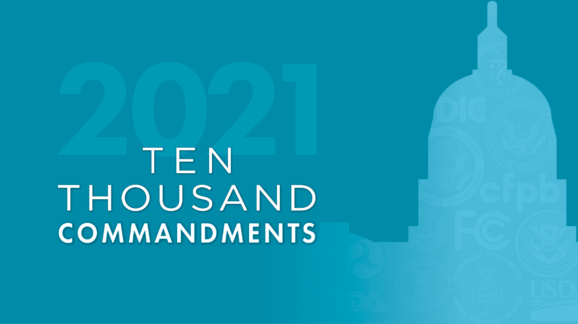A Breakdown of Rules in the White House’s Spring 2022 Unified Agenda of Federal Regulatory and Deregulatory Actions

Photo Credit: Getty
Since the early 1980s, federal departments and agencies have highlighted selected regulatory priorities in spring and fall editions of the Unified Agenda of Federal Regulatory and Deregulatory Actions. The Biden administration recently released the spring 2022 edition.
The Agenda’s historical roots lie in paperwork reduction, regulatory oversight and moderation, and a proclaimed commitment to balancing costs and benefits.
That has changed. In keeping with Biden’s regulatory campaigns in equity, climate, competition policy, cryptocurrency and other areas, the White House now regards the regulatory Agenda as “a way to share with the public how the themes of equity, prosperity and public health cut across everything we do to improve the lives of the American people.”
The shift in the wake of Biden’s presidential memorandum on “Modernizing Regulatory Review” has transformed the Office of Management and Budget (OMB) into a partner in regulating, not a traffic cop.
The spring 2022 Unified Agenda finds 67 federal agencies, departments, and commissions floating 3,803 rules and regulations at the “Active” (2673), “Completed” (556), and “Long-term” (574) stages. That compares to 3,777 in fall 2021 and to 3,959 in last year’s spring edition.
Trump counts were comparable, but there was a big difference. The former president’s final Unified Agenda in fall 2020 contained 653 rules designated “Deregulatory” for purposes of his now-defunct “one-in, two-out” Executive Order 13771, for a considerably lower “net.”
I took a look at it this week at Forbes, but didn’t include the full breakdown of the number of rules in the pipeline by Department and Agency. I’ve compiled that here.

Of the 3,803 rules in the new Agenda, 294 at various stages are considered “economically significant” (and a similar number “major;” see here for a deep dive on the nomenclature, but generally an economically significant rule is deemed to have $100 million in annual economic effects).
Biden’s significant rule counts appear to be returning to pre-Trump levels. The current breakdown is 36 recently Completed, 220 Active, and 38 being prepped for the Long term. Along with the costly economically significant subset, over 1,000 rules in each edition of the Agenda in recent years have been deemed “other significant,” no matter who is president. Here is the current breakdown of these heftier rule subsets.

For comparison, Trump’s final pandemic-afflicted December 2022 Agenda contained 261 economically significant rules, 36 of which were deemed “Deregulatory,” for a lower “net” of 225.
An economically significant rule is major, but a major rule is not necessarily economically significant, so there are fewer economically significant rules than major ones (an object in the universe can’t be bigger than the universe). But as reflected in the chart above in the “Active” category, some economically significant rule counts in various editions of the Agenda are larger than the count of major rules in some instances.
There may be different explanations for this discrepancy, such as a) calendar and fiscal years not aligning; b) rules not being reported to the Government Accountability Office (which tracks “majors”) but being noted at OMB; c) independent agency rules appearing under different categorizations in various databases; or d) differing treatment of budget and transfer rules.
Regardless, an executive order or legislation to systematize nomenclature could help bring greater clarity, reconcile record keeping across various government databases, and even subject independent agencies to greater oversight by Congress and the public.
As I’d noted at Forbes,
Biden’s regulatory Agendas promised and have delivered on activism. The OMB flip from carrying out Trump’s now-revoked “one-in, two-out” executive order to praising government’s own mandates and boasting over its advancement of progressive causes indicate that OIRA may not be salvageable as an oversight body. This transformation and rise of social custodianship is a major issue with which legislators need to grapple as they address the ongoing abuse of crises like the pandemic.
Next week we’ll dive a bit deeper on the economically significant subset, looking at which agencies are issuing what kind of rules.